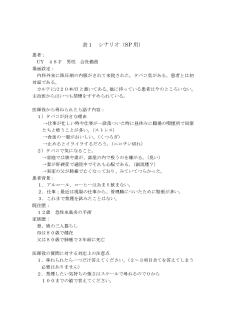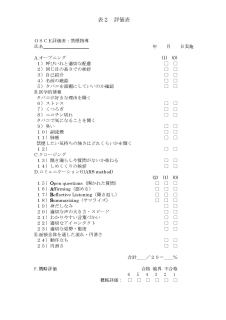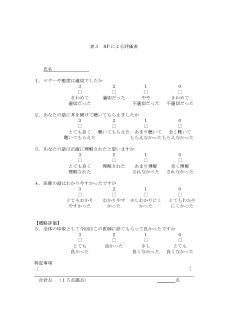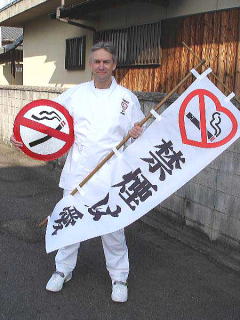Having garaged the support vehicle at Ibaraki Hospital and been driven
into central Osaka by Dr Inamoto the night before, we awoke in our home
stay at the office of anti-smoking activist Dr Nogami, thankful for another
rest day. Day 29 of the walk included a meeting with executive members
of the Osaka Pharmacists Association, where we were given the most up to
date information about their activities, including the previous months
request to pharmacists nationwide, to stop selling tobacco in their pharmacies.
Next was a meeting with the Osaka Medical Association, where despite a
warm welcome by all staff members, I had the feeling that the enthusiasm
and ideas for fighting the tobacco problem was less than positive.
However our next event was far more grass roots and positive, with an assorted group of supporters following Dr Nogami and myself on a walk through the city from Umeda Station to Namba Station. This assorted group included all ages; a University law student, a wheelchair bound lady, a young man desperately trying to quit smoking and several high school students and their teachers making good news coverage for the reporters present and for our friends from ABC TV who were continuing their mini-documentary about us.
Our last event was a semi-formal evening discussion with local anti-smoking members over a bento dinner where I was able to give my thoughts on the cultural and psychological differences between Australia and Japan and the effect this has on attacking the problem of tobacco in this country. I was also able to provide some suggestions for future anti-smoking activities before the meeting broke up at 8:30pm and we returned to Dr Nogami ’s office for some sleep.
May 12th saw an early rise at 6am to catch connecting trains and a taxi
to get back to our support vehicle and then to the start point in Ibaraki
to meet Tetsuya Hashimoto my walk companion for the day. He had read my
story in the newspaper and wanted to help because he suffers from skin
allergies related to tobacco smoke.
Setting off at a 7km/hr pace and taking a 15 minute break halfway, we
were able to arrive some 26km later at Kyoto JR train station at 12:30pm
with time to spare before my introduction at the annual Nurses Day event
being held in the mall beneath the station. A brief but warm reception
from the nurses and audience attending the event, after which Dr Tanaka,
our Kyoto event organiser drove us to his house come clinic, come clinic,
come temple. Here we were introduced to Dr Kurioka our home stay host for
the night.
With him in the passenger seat and Reiko asleep in the back, I was directed first to his hospital where I made another brief anti-smoking speech to his nursing staff and then on to his condominium where he changed out of his doctor ’s coat and into a chef’s apron and cooked us a lovely, healthy Japanese meal, before we retired early.
The next day I awoke to a canvas of grey skies and moderate but persistent
rain. A hearty breakfast cooked by Iron Chef Kurioka allowed me to walk
the 24km to Kusatsu in 4 hours and then return by train to Kyoto for the
afternoons anti-smoking education event, thus allowing Reiko some more
rest time.
At 4pm I met up with Reiko and Dr Tanaka’s NPO group at Shijo Bridge to
commence an education walk through Kyoto ’s crowded central shopping area.
About 15 members attended, for this first event of its kind in Kyoto, including
Dr Kato from Ehime, Dr Takahashi from Shiga, Dr Nakajima from Nara and
Mr Takemoto who walked with me in Okayama. Parading through the rain soaked
streets and picking up cigarette butts for an hour and a half with Dr Tanaka
handing out education leaflets the event seemed to be received quite positively.
To celebrate we attended a dinner at a no-smoking restaurant, “Taniguchi”
near Shijo Bridge. Whilst dining on local cuisine we were able to relax
and discuss events.
At this stage, having heard stories about the discord between some anti-smoking groups, I would just like to say, whilst I am not privy to the problems which exist between you neither do I care about these petty problems.
Your fight is with
“Big Tobacco” and trying to save the lives of those who are being destroyed everyday by this deadly product.
Please remember,
“United you Conquer, Divided you Fall”.
Day 32 was another rest day and good timing for my recuperating legs which continue to improve. The afternoon was devoted to business; the first of which was the opening of Dr Tanaka ’s “Tobacco-Free Museum”, at which I was given the honour of cutting the ribbon. About 20 people attended the opening and then donned gloves and tongs for a parade through the local undercover shopping arcade to pick up cigarette butts and hand out quit-smoking info-tissues.
Thankfully for me the highlight for most people in the mall was not me
but Dr Inamoto wearing a giant cigarette costume and stalking the local
children. Returning to the museum for a brief concluding ceremony we were
then free to view with interest the various posters, tobacco packets and
displays that Doctor Tanaka has collected from all over the world for his
unique museum. Having said final farewells to friends and guests, especially
to the Sonos ’, Dr Inamoto and Dr Kato who had all interrupted Mother ’s
Day celebrations to attend from other cities, we sat down with the Tanaka
family for a shabu-shabu dinner.
May 15th proved to be a very full day from lunch time onwards when Dr
Tanaka returned from his work at the clinic, and drove us to our first
meeting at the Kyoto City Hall. A genuinely impressive building with a
wide public space in front, marred by the large number of smokers who congregate
there, many on breaks from their civic duties. Likewise the large stone
entrance is scarred by a temporary looking smoking room, from which wafted
through the open door, the stench of tobacco smoke. Pity the poor non-smoking
citizens who have to walk through here to do business in the city office.
Met and guided to the office of the Director of Health by Dr Kurioka, I was immediately asked my thoughts about the state of smoking behaviour in Kyoto compared to the other cities I had already visited. My answer was to point out the window to the public space below as my first bone of contention. My further comments during the meeting were born from an increasing frustration at dealing with Japanese bureaucrats who continue to see the tobacco problem as one of good manners versus bad manners. I was tired of people skirting the issue, so I told the Director, through Reiko, in as straight forward terms as possible; “This is not a question of good manners or bad manners, it is a question of LIFE or DEATH.
” Consequently the meeting ended shortly there after, with me thinking I may have torpedoed Dr Tanaka ’s plans. However we were to learn later on the walk that the Kyoto City Office had indeed passed legislation to remove smokers from Kyoto ’s main shopping streets.
Our next meeting at the Kyoto Prefectural Office brought immediate changes
where we may have convinced them to place “quit smoking” posters and information
booklets in their smoking rooms. This was unfortunately a brief meeting
because we were out of time to get to Kusatsu by 3pm to resume my walk.
Arriving in Kusatsu we met up with Dr Takahashi of Shiga Prefecture, had
a brief meeting with Dr Ooi and his staff at the city office and then set
off from 4pm with a couple of Dr Takahashi ’s students from Biwako Seikei
Sports University. We completed the 24km to Minakuchi at my fastest pace
yet, thus proving the recuperative powers of Mr Tokumaru ’s massage on
my legs.
Day 34’s walk of 49km from Minakuchi to Suzuka again saw Dr Inamoto and his brother take time off from their busy schedules to accompany me through the rain and over the beautiful mountains to Mie Prefecture. At one point we were able to escape Route 1 and its diesel belching trucks and take the ancient Tokaido Path, past plantations of tea, through woods, past waterfalls and an ancient shrine and briefly forget about the blight of industrialisation as we breathed in the fresh mountain air.
The last day of week 5 saw me start the day in a bad mood probably due
to the smoking room dominating the lobby of our business hotel but as usual
something happens to put your life and your own efforts into perspective.
This morning that something was someone, Mr Iwasaki, who met up with us
shortly after I had started the mornings walk. His aim was to join me on
my walk for a while and prepare for his own Walk Against Tobacco in some
of the territory not covered by me. It wasn ’t until we started walking
and talking together that I found out that he had driven six hours through
the night without sleep from Toyama, just to walk with me for a while and
then return six hours to commence his company night shift work. It is certainly
efforts like this that both humble me and inspire me to keep walking against
tobacco.
|

5月11日、大阪府薬剤師会訪問

田中医院内に開館したタバコ博物館開館式にて

城北病院の皆さんに歓迎されて

びわこ成蹊スポーツ大学の皆さんと草津保健所前にて

鈴鹿に向かう途中の茶畑で大雨にあう
|













